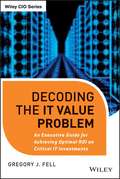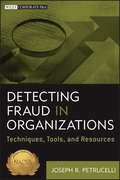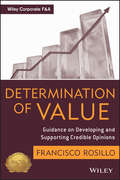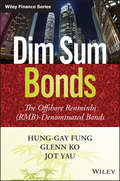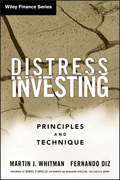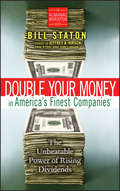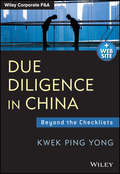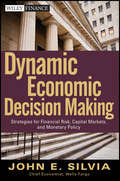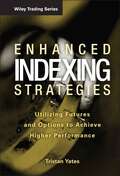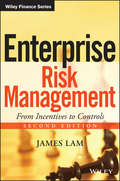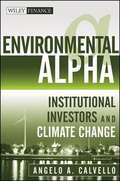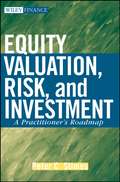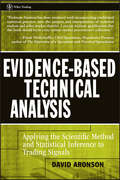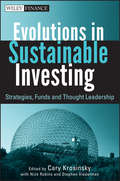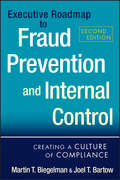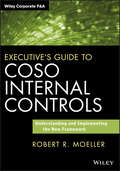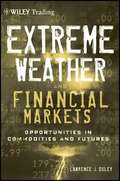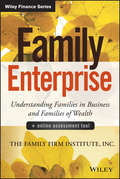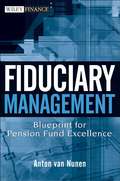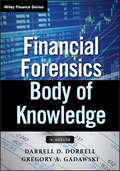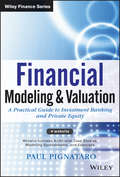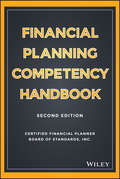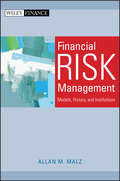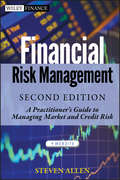- Table View
- List View
Decoding the IT Value Problem
by Gregory J. FellGain greater returns from your IT investmentsRevealing the secrets to proven, effective strategies that enable businesses to leverage the full value of highly expensive IT investments, Decoding the IT Value Problem is a no-nonsense guide for making smart IT investments and cutting through the noise of vendor marketing and media hype. Author Gregory Fell describes in rich detail the actual processes, frameworks, infrastructure and discipline required to develop and execute corporate IT strategies that areprofitable and sustainable.Provides a proven framework for developing and successfully executing profitable IT strategiesPlain English guidance for gaining the most return on investment from critical IT investmentsExplores developing and executing IT strategy; forecasting, calculating and managing IT costs; leveraging IT investments to drive business growth; IT and the evolving global economy; IT value management; communicating IT value across the enterprise; and leading change, transformation and innovationIf you're a senior level manager or executive responsible for managing IT value in your business, Decoding the IT Value Problem is the practical and clearly written guide you'll turn to, with tools and tips for smart investment and management of IT costs.
Detecting Fraud in Organizations: Techniques, Tools, and Resources (Wiley Corporate F&A #644)
by Joseph PetrucelliA savvy examination of where people and value meet, creating the opportunity for fraudAn essential reference for all business professionals, Detecting Fraud in Organizations: Techniques, Tools, and Resources explains the process of how people commit fraud, as well as how to prevent and stop fraud from occurring in your organization. Organized by business processes which succinctly describe how fraud manifests itself on a daily basis, the authors explain ways in which everyone can help guard against fraud by familiarizing themselves with its building blocks and methods used to perpetrate and conceal it. Filled with situational examples the book is accompanied by a website featuring fraud simulations, business process maps, and other useful tools for combating fraud.Focuses on the people who perpetrate fraud and those who are tasked with preventing and detecting itUniquely organized by business processes for more relevance and easier understanding by those people working within organizationsShows how subtle factors play a large role in identifying and ferreting out fraud in addition to the traditional knowledge of fraud schemes giving people and organizations the edge they need to be successful in prevention and deterrenceCompanion website includes additional fraud simulations, business process maps, and useful toolsThe price of fraud can be devastating to your business. Detecting Fraud in Organizations: Techniques, Tools, and Resources equips you and others in your organization with essential information and tools necessary to proactively catch fraud, reduce losses, improve efficiencies and develop actionable controls.
Determination of Value
by Francisco RosilloHow to develop and support a credible opinion of value based on a foundational framework This book provides knowledge and guidance to valuation practitioners on achieving a new level of professionalism and credibility, as well as to those stakeholders in the valuation process in need of assessing the credibility of an appraiser's work product for decision-making purposes. It introduces a well defined framework of key credibility concepts and procedures at each step of the appraisal process, including reasonableness tests, valuation methodologies, financial analysis, economic and industry analysis, engagement planning, and informed judgment. Provides needed guidance to valuation practitioners to enhance their valuation practice and improve the credibility of the appraiser's work product Offers guidance to stakeholders in the valuation process in need of assessing the credibility of an appraiser's work product for decision-making purposes Get foundational framework appraisal advice with the proven guidance found in Determination of Value.
Dim Sum Bonds
by Hung-Gay Fung Glenn Chi-Wo Ko Jot YauA comprehensive guide to understanding and assimilating into dim sum bond marketsThe expansive growth of the dim sum bond market in the last five years has peaked investor interest and inspired companies to seek out investing opportunities that negate China's capital controls. In a four-pronged approach, Dim Sum Bonds examines the development of the dim sum bond market and its role in China's RMB internationalization policy, characteristics of dim sum bonds and its market, investors' investment objectives and the investment performance of dim sum bonds, motivations of issuers, and underwriters' roles in the dim sum bond market. You will familiarize yourself with every aspect of the dim sum bond market from an issuer, an investor, and an underwriter's perspective. Academics, financial advisors, investment bankers, underwriters, investors, and policy makers should not be without this informative and detailed guide to the offshore market central to China's internationalization of RMB.Written by Hung-Gay Fung, Glenn Chi-Wo Ko, and Jot Yau, all of whom are experts on the dim sum bond marketExplains the rapidly expanding dim sum bond market and puts readers ahead of the curveLandmark issues, Chinese banks (China Development Bank), Infrastructure, red-chip companies (Sinotruk), and multinational corporations doing business in China (McDonald's) are discussed in detail.Covering landmark issues from a variety of Chinese and multinational corporations, Dim Sum Bonds provides must-read manual to understanding the vast opportunities of this up-and-coming market.
Distress Investing
by Daniel Whitman Martin J. Diz Fernando D'AnielloPraise for Distress Investing "Marty Whitman has distilled decades of distressed investing experience into a text that is a must-read for everyone interested in the field, whether a student or a professional investor. " -Wilbur L. Ross, Chairman and CEO, WL Ross & Co. LLC "Distress Investing: Principles and Technique represents a detailed and unique perspective on an arcane arena of investment that is going to get a lot more attention. Marty Whitman is the master, and has set the standard for many years. " -Sam Zell, Chairman, Equity Group Investments, LLC "Martin Whitman and Professor Diz have produced a seminal work on the ins and outs of distressed investing for all distressed debt investors. It is jam-packed with information and guidance for the novice and the experienced. A must-read for anyone interested in distressed investing. " -Lewis Kruger, Stroock & Stroock & Lavan LLP "Marty Whitman, a legend in distress investing, packs decades of experience into these pages. The restructuring of the capital markets currently under way is sure to provide great distress investment opportunities, which this guide book can make count for you. " -Bruce Flatt, Brookfield Asset Management Inc. "The principles found in this book are those I used in the reorganization of my business from bankruptcy to an S&P 500 company with an investment grade rating and a multibillion-dollar market capitalization. An excellent premier by Marty Whitman and Professor Diz, integrating economic theory with real-world investment to help investors of all shapes and sizes understand and invest in distressed securities. " -Gene Isenberg, Chairman and CEO, Nabors Industries, Inc. "Marty Whitman, the unquestioned 'Dean' of active distressed investors, and Fernando Diz, one of the few academics specializing in distressed investing, have teamed up to provide perhaps the best and most comprehensive primer on distressed securities and markets. I learned so much from this remarkable volume. " -Edward I. Altman, Max L. Heine Professor of Finance, NYU Stern School of Business, Director of credit and debt markets research at the NYU Salomon Center and adviser to several financial institutions including, Paulson & Co. and Concordia Advisers
Double Your Money in America's Finest Companies
by Bill Staton HirschA detailed guide to investing in America's Finest CompaniesBill Staton has helped thousands of investors increase their wealth with a commonsense approach to investing. It's simple, and it works: Invest in well-run, profitable companies with long histories of rising annual earnings and dividends. Now, in Double Your Money in America's Finest Companies, Staton shows readers how to achieve this goal. He reveals how to screen public companies, scrutinize their earnings history, and invest in those that consistently pay higher yearly cash dividends. Staton's longstanding method of investing allows readers to take charge of their financial future by following an approach that has proven itself time and again.
Due Diligence in China
by Kwek Ping YongA plain-English guide that demystifies the business landscape in China from a due diligence point of viewDue diligence is crucial to any business deal, and, thankfully, due diligence research has come a long way over the years. What used to be a cumbersome, time-consuming process has been standardized and systemized with generally accepted auditing frameworks and tools, such as the all-important auditing "checklists." But when it comes to doing due diligence in China, with its opaque regulatory system and byzantine accounting standards, all bets are off. In this book an acknowledged expert in the field takes you beyond the checklists to arm you with China-specific due diligence strategies, tools and techniques that go beyond what is typically part of the process.Gives a detailed account of why conventional frameworks used in the west simply don't work in ChinaProvides first-hand accounts based on the author's years of experience as a private equity professional doing deals in ChinaReviews, in-depth, the unique differences between corporations and businesses in China and those in the West and their implications for the due diligence processUses numerous case studies to guide the reader through an entire due diligence process for a firm in China
Dynamic Economic Decision Making
by John SilviaA comprehensive analysis of the macroeconomic and financial forces altering the economic landscapeFinancial decision-making requires one to anticipate how their decision will not only affect their business, but also the economic environment. Unfortunately, all too often, both private and public sector decision-makers view their decisions as one-off responses and fail to see their decisions within the context of an evolving decision-making framework.In Decision-Making in a Dynamic Economic Setting, John Silvia, Chief Economist of Wells Fargo and one of the top 5 economic forecasters according to Bloomberg News and USA Today, skillfully puts this discipline in perspective.Details realistic, decision-making approaches and applications under a broad set of economic scenariosAnalyzes monetary policy and addresses the impact of financial regulationsExamines business cycles and how to identify economic trends, how to deal with uncertainty and manage risk, the building blocks of growth, and strategies for innovationDecision-Making in a Dynamic Economic Setting details the real-world application of economic principles and financial strategy in making better business decisions.
Enhanced Indexing Strategies
by Tristan YatesLeveraged index investments, including index futures, options, and ETFs, are one of the fastest growing products in finance, as both retail and institutional investors are attracted to their long-term returns and capital efficiency. With Enhanced Indexing Strategies, author Tristan Yates reveals how you can create and build high-performance indexing strategies using derivatives that can potentially generate much higher returns than conventional index investing. In addition, Enhanced Indexing Strategies introduces six innovative long-term indexing strategies using futures and options, each with its own advantages and applications.
Enterprise Risk Management
by James LamA fully revised second edition focused on the best practices of enterprise risk managementSince the first edition of Enterprise Risk Management: From Incentives to Controls was published a decade ago, much has changed in the worlds of business and finance. That's why James Lam has returned with a new edition of this essential guide. Written to reflect today's dynamic market conditions, the Second Edition of Enterprise Risk Management: From Incentives to Controls clearly puts this discipline in perspective.Engaging and informative, it skillfully examines both the art as well as the science of effective enterprise risk management practices. Along the way, it addresses the key concepts, processes, and tools underlying risk management, and lays out clear strategies to manage what is often a highly complex issue.Offers in-depth insights, practical advice, and real-world case studies that explore the various aspects of ERMBased on risk management expert James Lam's thirty years of experience in this fieldDiscusses how a company should strive for balance between risk and returnFailure to properly manage risk continues to plague corporations around the world. Don't let it hurt your organization. Pick up the Second Edition of Enterprise Risk Management: From Incentives to Controls and learn how to meet the enterprise-wide risk management challenge head on, and succeed.
Environmental Alpha
by Angelo CalvelloThe definitive guide to how institutional investors should approach the risks and opportunities associated with climate changeEnvironmental Alpha provides institutional investors with the comprehensive framework they need to assess the risks and investment opportunities tied to climate change.Climate change will present institutional investors with some of the most important risks and opportunities they will face for generations to come. Climate change has the potential to affect many sectors in radically different degrees over time, and institutional investors need to have a thorough understanding of the multi-dimensional risks and opportunities that could influence nearly every investment in their portfolios. This volume is composed of contributions by leading experts in environmental investment, moving beyond the theoretical or academic nature of much of the current discussion on the topic to provide you with real-world insights into an emerging market.Examines the climate change-related drivers of returns (science, economics, policy, and technology) that make environmental alpha possibleExplores fiduciary duty and climate changeContains in-depth explanations of each of the major categories of environmental investing and examines related environmental alpha opportunitiesDiscusses practical implementation issuesPresents real-world case studies and examplesClimate change will be one of the most important investment themes of the next twenty years; the related environmental investment opportunities will provide institutional investors with some of the greatest "alpha" opportunities for years to come. This book will put you in a better position to assess and access these opportunities.
Equity Derivatives
by Laurent Nguyen-Ngoc Gero Schindlmayr Marcus Overhaus Frank Mao Thomas Knudsen Andrew FerrarisWritten by the quantitative research team of Deutsche Bank, the world leader in innovative equity derivative transactions, this book acquaints readers with leading-edge thinking in modeling and hedging these transactions. Equity Derivatives offers a balanced, integrated presentation of theory and practice in equity derivative markets. It provides a theoretical treatment of each new modeling and hedging concept first, and then demonstrates their practical application. The book covers: the newest and fastest-growing class of derivative instruments, fund derivatives; cutting-edge developments in equity derivative modeling; new developments in correlation modeling and understanding volatility skews; and new Web-based implementation/delivery methods.Marcus Overhaus, PhD, Andrew Ferraris, DPhil, Thomas Knudsen, PhD, Frank Mao, PhD, Ross Milward, Laurent Nguyen-Ngoc, PhD, and Gero Schindlmayr, PhD, are members of the Quantitative Research team of Deutsche Bank's Global Equity Division, which is based in London and headed by Dr. Overhaus.
Equity Valuation, Risk and Investment
by Peter C. StimesAuthor Peter Stimes's analysis of the investment process has long been inspired by some of the best minds in the world of finance, yet some of the ways in which he approaches this discipline are truly unique. In Equity Valuation, Risk, and Investment, Stimes shares his extensive expertise with you and reveals how practitioners can integrate and apply both the theory and quantitative analysis found in finance to the day-to-day decisions they must make with regard to important investment issues.
Evidence-Based Technical Analysis
by David AronsonEvidence-Based Technical Analysis examines how you can apply the scientific method, and recently developed statistical tests, to determine the true effectiveness of technical trading signals. Throughout the book, expert David Aronson provides you with comprehensive coverage of this new methodology, which is specifically designed for evaluating the performance of rules/signals that are discovered by data mining.
Evolutions in Sustainable Investing
by Cary Krosinsky Nick Robins Stephen ViedermanSustainable Investing is fast becoming an essential method of generating long-term returns, moving beyond the negative approaches to socially responsible investing that have dominated the field. This book, our second on the subject, provides over 15 case studies of leading global investors and companies demonstrating how they successfully apply sustainability aspects to their core strategies. Learn from prominent thought leaders Dan Esty and Paul Hawken among others who have contributed key chapters. Our chapter on performance shows clearly how these strategies have been working once negative approaches are parsed out by those examining fund returns. This book also examines in great depth what data exists, and what's on the horizon, to best measure & capture sustainability successfully. Regional perspectives, including 3 chapters on Asia, and focuses on Canada, Australia, Africa & India are also included, as is a look across asset classes. Sustainable Investing, when performed with a positive perspective, has been outperforming the mainstream, unlike negative approaches designed to match benchmark returns. From eco-efficiency to sustainability-driven innovation and beyond, investors of all shapes & sizes need to know how best to position themselves for the radical market shifts underway.
Executive Roadmap to Fraud Prevention and Internal Control
by Martin T. Biegelman Joel T. BartowNow in a Second Edition, this practical book helps corporate executives and managers how to set up a comprehensive and effective fraud prevention program in any organization. Completely revised with new cases and examples, the book also discusses new global issues around the Foreign Corrupt Practices Act (FCPA). Additionally, it covers best practices for establishing a unit to protect the financial integrity of a business, among other subjects. The book has many checklists and real-world examples to aid in implementation and an instructor's URL including a test bank to aid in course adoptions.
Executive's Guide to COSO Internal Controls
by Robert R. MoellerEssential guidance on the revised COSO internal controls frameworkNeed the latest on the new, revised COSO internal controls framework? Executive's Guide to COSO Internal Controls provides a step-by-step plan for installing and implementing effective internal controls with an emphasis on building improved IT as well as other internal controls and integrating better risk management processes. The COSO internal controls framework forms the basis for establishing Sarbanes-Oxley compliance and internal controls specialist Robert Moeller looks at topics including the importance of effective systems on internal controls in today's enterprises, the new COSO framework for effective enterprise internal controls, and what has changed since the 1990s internal controls framework.Written by Robert Moeller, an authority in internal controls and IT governancePractical, no-nonsense coverage of all three dimensions of the new COSO frameworkHelps you change systems and processes when implementing the new COSO internal controls frameworkIncludes information on how ISO internal control and risk management standards as well as COBIT can be used with COSO internal controlsOther titles by Robert Moeller: IT Audit, Control, and Security, Executives Guide to IT GovernanceUnder the Sarbanes-Oxley Act, every corporation has to assert that their internal controls are adequate and public accounting firms certifying those internal controls are attesting to the adequacy of those same internal controls, based on the COSO internal controls framework. Executive's Guide to COSO Internal Controls thoroughly considers improved risk management processes as part of the new COSO framework; the importance of IT systems and processes; and risk management techniques.
Extreme Weather and Financial Markets
by Lawrence J. OxleyThe positive effects of climate change on the market Record-setting snowfall, cyclones in Australia, chronic drought in Russia, and other dramatic weather events are getting increased attention from scientists and the general public. The effects of climate change present challenges to many sectors, but also present major investing opportunities in the stock, bond, and futures markets. Extreme Weather and The Financial Markets looks at climate change from an investor's standpoint. The climate change debate is somewhat irrelevant to those in the financial industry, since we already live with more than enough extreme climate events to impact the financial markets. To the extent that environmental scientists are correct and global climate change is real and getting worse, the more investment opportunities we have The book presents investment ideas that will work under today's global climate condition and will become even more lucrative if global climate change continues Written by Larry Oxley, an acclaimed author who has personally outperformed the index in the Basic Materials sectors (i. e. chemicals, metals, mining, and forest products) for each of the last five years--in both good and bad markets and throughout the global recession--in a portfolio of nearly $2 billion Focusing on the investment opportunities during dramatic weather events, Extreme Weather and The Financial Markets offers advice on how to capitalize on global climate change.
Family Enterprise
by The Family Firm Institute, IncA thorough explanation of how family enterprises workThe family enterprise, whether an operating business, a family office, or both, is the backbone of the US and international economies. These enterprises cut across industries and geographies and can be first-generation entrepreneurial companies or multi-generational businesses with family offices. This book offers a foundation in and understanding of how family enterprises work, including working definitions and the key characteristics of family enterprises, as well as useful concepts for working with and in family enterprises, either as a professional or as a family member.Written by the experts at the Family Firm Institute, a global network of professionals, educators, researchers, and owners of family enterprisesAn ideal resource for professionals in law, finance, management, and behavioral science, family office and fund managers, and others interested in an multidisciplinary approach to this field
Fiduciary Management
by A. Van NunenFiduciary Management offers an in-depth explanation of every facet of this fast-growing approach to organizing the management of an institutional investment portfolio. Expert author Anton van Nunen begins by outlining the historic shift that has brought this strategy to the attention of the investment community and quickly moves on to illustrate fiduciary management in practice; giving advice in terms of asset-liability modeling and financial markets, constructing portfolios, selecting and overseeing investment managers, benchmarking and performance measurement, and reporting.
Financial Forensics Body of Knowledge
by Darrell D. Dorrell Gregory A. GadawskiThe definitive, must-have guide for the forensic accounting professional Financial Forensics Body of Knowledge is the unique, innovative, and definitive guide and technical reference work for the financial forensics and/or forensic accounting professional, including nearly 300 forensic tools, techniques, methods and methodologies apply to virtually all civil, criminal and dispute matters. Many of the tools have never before been published. It defines the profession: "The Art & Science of Investigating People & Money. " It defines Forensic Operators: ". . . financial forensics-capable personnel. . . possess unique and specific skills, knowledge, experience, education, training, and integrity to function in the financial forensics discipline. " It defines why: "If you understand financial forensics you understand fraud, but not vice versa" by applying financial forensics to all aspects of the financial community. It contains a book-within-a-book Companion Section for financial valuation and litigation specialists. It defines foundational financial forensics/forensic accounting methodologies: FAIM, Forensic Accounting Investigation Methodology, ICE/SCORE, CICO, APD, forensic lexicology, and others. It contains a Reader Lookup Table that permits everyone in the financial community to immediately focus on the pertinent issues.
Financial Modeling and Valuation
by Paul PignataroWritten by the Founder and CEO of the prestigious New York School of Finance, this book schools you in the fundamental tools for accurately assessing the soundness of a stock investment. Built around a full-length case study of Wal-Mart, it shows you how to perform an in-depth analysis of that company's financial standing, walking you through all the steps of developing a sophisticated financial model as done by professional Wall Street analysts. You will construct a full scale financial model and valuation step-by-step as you page through the book.When we ran this analysis in January of 2012, we estimated the stock was undervalued. Since the first run of the analysis, the stock has increased 35 percent. Re-evaluating Wal-Mart 9months later, we will step through the techniques utilized by Wall Street analysts to build models on and properly value business entities.Step-by-step financial modeling - taught using downloadable Wall Street models, you will construct the model step by step as you page through the book.Hot keys and explicit Excel instructions aid even the novice excel modeler.Model built complete with Income Statement, Cash Flow Statement, Balance Sheet, Balance Sheet Balancing Techniques, Depreciation Schedule (complete with accelerating depreciation and deferring taxes), working capital schedule, debt schedule, handling circular references, and automatic debt pay downs.Illustrative concepts including detailing model flows help aid in conceptual understanding.Concepts are reiterated and honed, perfect for a novice yet detailed enough for a professional.Model built direct from Wal-Mart public filings, searching through notes, performing research, and illustrating techniques to formulate projections.Includes in-depth coverage of valuation techniques commonly used by Wall Street professionals.Illustrative comparable company analyses - built the right way, direct from historical financials, calculating LTM (Last Twelve Month) data, calendarization, and properly smoothing EBITDA and Net Income.Precedent transactions analysis - detailing how to extract proper metrics from relevant proxy statementsDiscounted cash flow analysis - simplifying and illustrating how a DCF is utilized, how unlevered free cash flow is derived, and the meaning of weighted average cost of capital (WACC)Step-by-step we will come up with a valuation on Wal-MartChapter end questions, practice models, additional case studies and common interview questions (found in the companion website) help solidify the techniques honed in the book; ideal for universities or business students looking to break into the investment banking field.
Financial Planning Competency Handbook
by Cfp BoardThe official guide for exam success and career excellence Financial Planning Competency Handbook, Second Edition is the essential reference for those at any stage of certification and a one-stop resource for practitioners looking to better serve their clients. This fully updated second edition includes brand new content on connections diagrams, new case studies, and new instructional videos, and a completely new section devoted to the interdisciplinary nature of financial planning. You'll gain insights from diverse fields like psychology, behavioral finance, communication, and marriage and family therapy to help you better connect with and guide your clients, alongside the detailed financial knowledge you need to perform to the highest expectations as a financial planner. This book contains over ninety chapters that are essential for practitioners, students, and faculty. Whether a practitioner, student, or faculty member, this guide is the invaluable reference you need at your fingertips. Comprehensive, clear, and detailed, this handbook forms the foundation of the smart financial planner's library. Each jurisdiction has its own laws and regulations surrounding financial planning, but the information in this book represents the core body of knowledge the profession demands no matter where you practice. Financial Planning Competency Handbook, Second Edition guides you from student to practitioner and far beyond, with the information you need when you need it.
Financial Risk Management
by Allan M. MalzFinancial risk has become a focus of financial and nonfinancial firms, individuals, and policy makers. But the study of risk remains a relatively new discipline in finance and continues to be refined. The financial market crisis that began in 2007 has highlighted the challenges of managing financial risk. Now, in Financial Risk Management, author Allan Malz addresses the essential issues surrounding this discipline, sharing his extensive career experiences as a risk researcher, risk manager, and central banker. The book includes standard risk measurement models as well as alternative models that address options, structured credit risks, and the real-world complexities or risk modeling, and provides the institutional and historical background on financial innovation, liquidity, leverage, and financial crises that is crucial to practitioners and students of finance for understanding the world today.Financial Risk Management is equally suitable for firm risk managers, economists, and policy makers seeking grounding in the subject. This timely guide skillfully surveys the landscape of financial risk and the financial developments of recent decades that culminated in the crisis. The book provides a comprehensive overview of the different types of financial risk we face, as well as the techniques used to measure and manage them. Topics covered include:Market risk, from Value-at-Risk (VaR) to risk models for optionsCredit risk, from portfolio credit risk to structured credit productsModel risk and validationRisk capital and stress testingLiquidity risk, leverage, systemic risk, and the forms they takeFinancial crises, historical and current, their causes and characteristicsFinancial regulation and its evolution in the wake of the global crisisAnd much moreCombining the more model-oriented approach of risk management-as it has evolved over the past two decades-with an economist's approach to the same issues, Financial Risk Management is the essential guide to the subject for today's complex world.
Financial Risk Management
by Steven AllenA top risk management practitioner addresses the essential aspects of modern financial risk management In the Second Edition of Financial Risk Management + Website, market risk expert Steve Allen offers an insider's view of this discipline and covers the strategies, principles, and measurement techniques necessary to manage and measure financial risk. Fully revised to reflect today's dynamic environment and the lessons to be learned from the 2008 global financial crisis, this reliable resource provides a comprehensive overview of the entire field of risk management. Allen explores real-world issues such as proper mark-to-market valuation of trading positions and determination of needed reserves against valuation uncertainty, the structuring of limits to control risk taking, and a review of mathematical models and how they can contribute to risk control. Along the way, he shares valuable lessons that will help to develop an intuitive feel for market risk measurement and reporting. Presents key insights on how risks can be isolated, quantified, and managed from a top risk management practitioner Offers up-to-date examples of managing market and credit risk Provides an overview and comparison of the various derivative instruments and their use in risk hedging Companion Website contains supplementary materials that allow you to continue to learn in a hands-on fashion long after closing the book Focusing on the management of those risks that can be successfully quantified, the Second Edition of Financial Risk Management + Websiteis the definitive source for managing market and credit risk.
